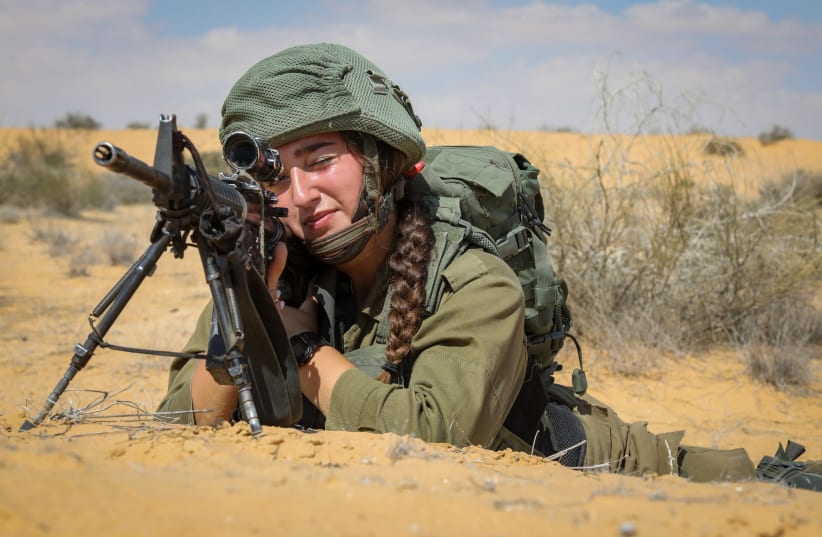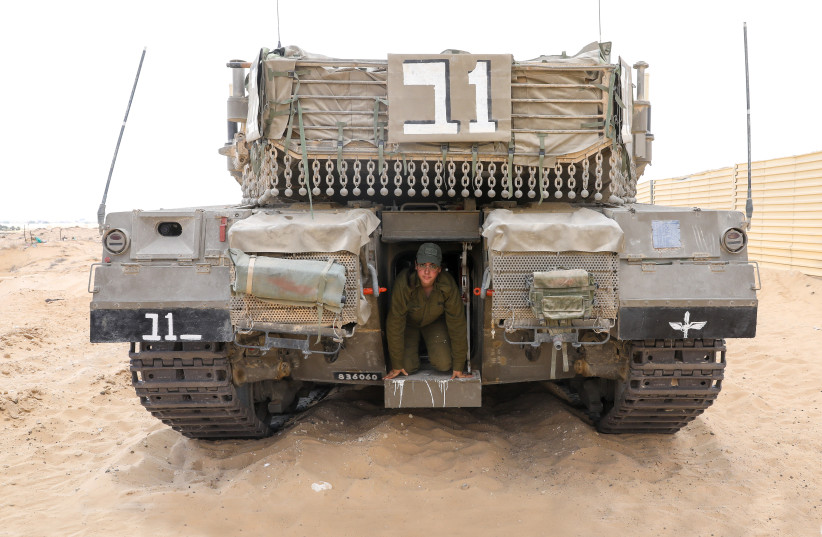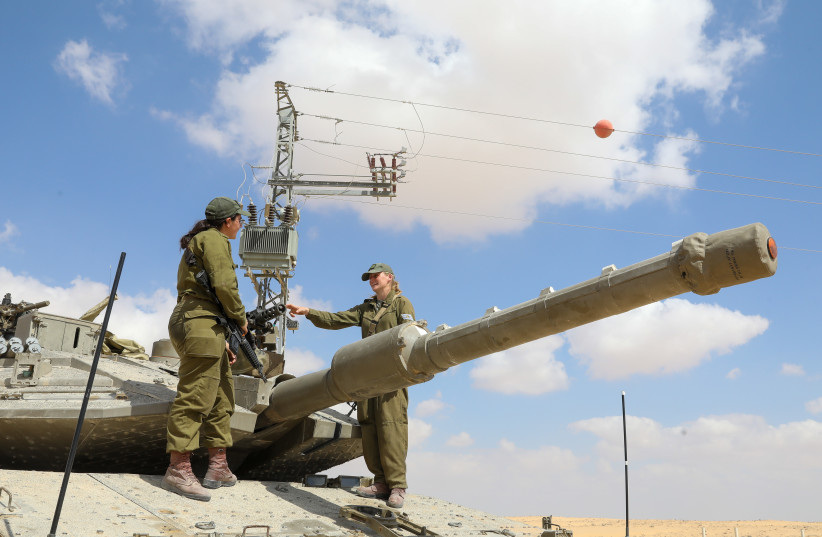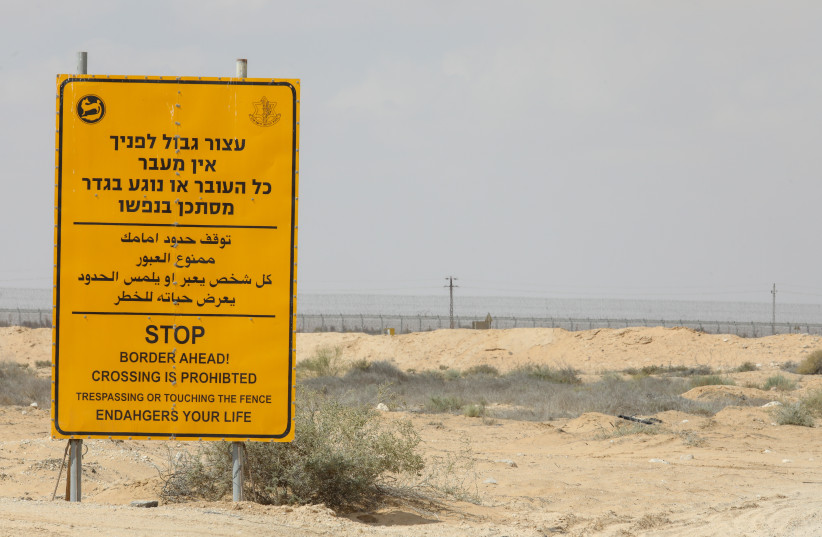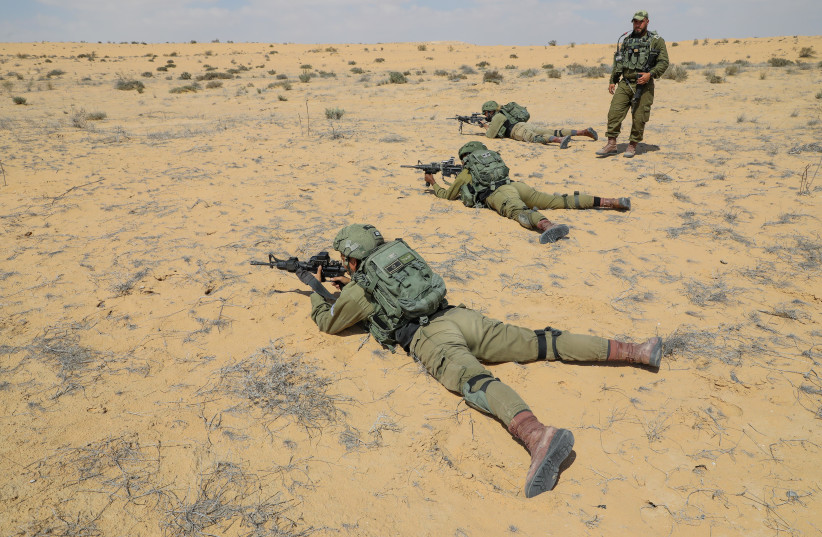Deep in the Negev sit a pair of Merkava IV tanks, operated by Israel’s first female tank crews. The women, making history, are keeping a close eye on the Egyptian border, ready for any threat that might appear.
The tanks and their crews are guarding one of Israel’s longest borders, and while there has been peace with Egypt for more than 40 years, the 240-kilometer long border with the restive Sinai Peninsula sees almost daily action for IDF troops: regular smuggling attempts as well as terror attacks by the Islamic State terror group’s Sinai Province.
Operating Merkava IV tanks, the company of all-female tank operators are serving under the command of the Paran Brigade and serve as tank operators in the mixed-gender Caracal Battalion.
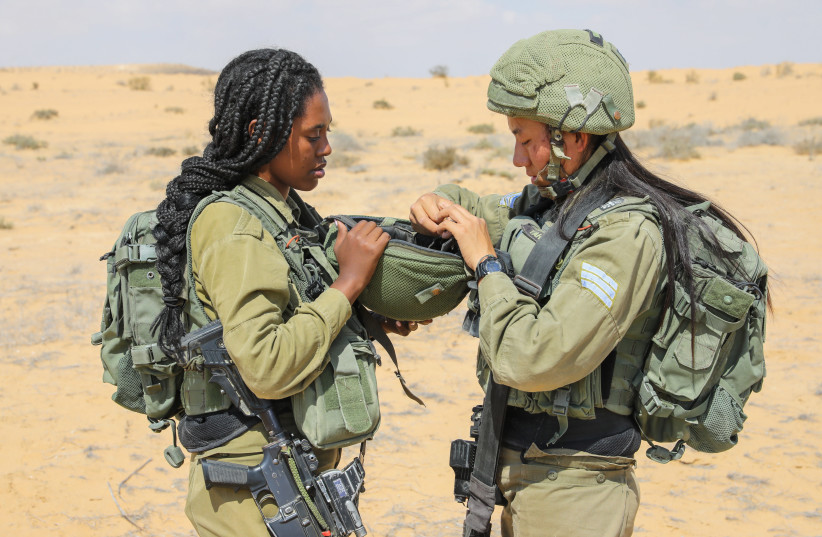
The female tank crews are deployed to the border as part of a second pilot program to assess whether or not to integrate women into the IDF’s Armored Corps.
Some 19 women began the second pilot and completed basic training with troops from the mixed-gender Border Defense units. They then completed their training at Shizafon Base in the Negev, home to the IDF’s Armored Corps School, before 10 women were deployed to the Egyptian border to take part in operational duty under the command of the Caracal Battalion, one of four mixed-gender infantry units within the IDF’s Border Defense Corps, which is responsible for defending Israel’s borders with Jordan and Egypt.
Cpl. Noam Hen is the driver of one of the two tanks and is still in shock that she drives such a powerful platform. Hen has always wanted to be in combat; since she was a kid she wanted to be the first person in her family to be in a combat position.
“Driving a tank is not like driving a car,” she told the Magazine as she showed us her tank. “As a driver, the biggest fear is a fire. There’s a lot of danger inside a tank, not only from the enemies who are outside.”
According to her, the women in the pilot are doing the exact same thing as their male counterparts. They went through the same basic training and are carrying out the same operational orders along the border.
“The hardest thing about being in the armored corps is taking care of the tank. Tanks need a lot of love and care. It takes a lot of energy, 24/7,” Hen said.
IN JUNE 2019, the IDF said that four female soldiers successfully completed a pilot program to train on tanks and become tank commanders. But several months later, it reversed the decision and said that the next stage of the pilot program “would require significantly more manpower and resources to undertake.”
The main focus of the initial pilot was the physical abilities of the female recruits, who are divided into teams led by a male soldier commanding a Merkava Mark III tank. Throughout all phases of the program, the recruits were accompanied by experienced tank commanders, doctors, nutritionists and fitness experts.
In the second pilot program, at least twice the size of the previous one, the military has increased the height and weight requirements of women who want to take part in the program and expanded the time that women will be deployed to carry out operational missions. Hen said that the new requirements are important to prevent harm to the crew, but those in the second pilot were never told why the first was not successful.
One senior officer who serves in the 53rd Armored Battalion told the Magazine in a recent interview that loading shells is only one of several challenges for women to serve in tanks. Discussing the recent fighting between Israel and Gaza, the officer said that troops need to spend long amounts of time in the tank, hinting that it might be uncomfortable for women.
Chuckling at the issue, Hen said, “You find solutions for everything, especially if there is a threat outside.” She says she has spent more than 12 hours in her tank along with the crew and while “it’s not easy, other things make up for it. You and your team are there together.”
While the pilot programs seem to be successful, many are against the concept, including former IDF Chief Rabbi Yisrael Weiss, who argued that if a male and female soldier are put “into a closed box for a week... you’ll get a little tank soldier in another nine months.”
But, with only women serving in the tank that’s out of the question.
Should the second pilot program be deemed successful, the IDF has stated that there would be no mixed-gender tank crews, and female tank crews will not be part of battalions that would operate in enemy territory; they would instead be deployed only to the borders.
While the women are taking part in operational duty, their deployment does not mean that the pilot was successfully completed. According to the military, the success of the pilot will be determined by a number of factors, including long-term operational activity, quality force building and more.
In January 2020, two of the women who completed the first pilot program – Osnat Levi and Noga Shina, along with one of the officers who accompanied their training, Afik Shema – filed a petition against the decision to bar women from the armored corps.
The IDF said that the reason for the decision was the cost-benefit calculations of the separate training and allocation of combat units and not the physical abilities of the female soldiers.
Several months later, in September, 19-year-old Or Abramson from Karnei Shomron and Maayan Halberstadt of Jerusalem also filed a petition seeking to have the military explain why women are barred from serving as tank drivers, gunners, radio operators and commanders. Their petition, which calls for the Supreme Court to change regulations to allow women to serve in frontline combat positions, claims that the army’s refusal to let them serve in tanks is a substantial violation of equal rights.
Hen told the Magazine that she didn’t understand why there are those who oppose the pilot.
“They don’t really know what’s going on here. The data proves that we are just like the men,” she said. “I really believe in this pilot and if we can succeed in it, then other women can too.”
THE DEFENSE Service Law states that every person – man or woman – has the right to serve in any position in the military unless the inherent nature of the position requires otherwise. In 1949, Israel’s army became the first in the world to introduce mandatory military service for both men and women, but shortly after, women were once again barred from combat positions.
In recent years the IDF has increased the recruitment of women to combat units like the Caracal and Bardelas mixed-gender border defense battalions. Both Caracal and Bardelas serve under the 80th Division’s Paran brigade with their headquarters at Ketziot, in an area that has been marked as vulnerable to threats like drug smuggling due to the settlements in the region. The Paran brigade troops are deployed to protect territory along the border to the city of Eilat, where troops will train and operate as needed. And like the desert in which they operate, troops wear camouflaged speckled, yellow, green, with brown berets and red boots.
After a short drive from the tanks down several dirt roads we arrived at an exercise being held by troops from the Bardelas battalion. Women and men were huddled together under a tent, resting before the next part of the drill, while others were busy cleaning their rifles.
The Magazine sat down with three women serving in the unit, under a tree in some shade from the hot desert sun. All of them wanted to be in combat units, including Sergeant Hannah Solomon, who made aliyah from London.
“I’m the first in my family to make aliyah and to draft into the IDF. I didn’t want to go right to university like all of my friends; I wanted to join the IDF first. And not joining a combat unit wasn’t even a question after coming all the way here,” she said. “I wasn’t going to leave my whole family and all my friends just to sit in an office.”
Sitting next to Solomon was Sergeant Dor Elzayad, who since high school wanted to be a fighter.
“My whole family served in military intelligence, but I wanted something more meaningful. I didn’t want to be a jobnik,” she said, referring to non-combat roles. “People are still in shock, but we did basic training and we do all the same drills as men. Male soldiers have worked with us; they’ve seen us do everything that they do.”
Like the female tank crews, the troops of the Baredlas battalion are deployed to the border with Egypt and see almost nightly action stopping smuggling and thwarting terror attacks.
Cairo and Jerusalem have been reported by foreign press to have been closely cooperating in the Sinai Peninsula in the fight against ISIS militants and smugglers since Egyptian strongman President Abdel Fatah al-Sisi rose to power. Sisi has waged extensive military operations against ISIS in the Sinai, and while the terror group has lost much of its strength, it remains active. Despite its small size, it continues to carry out deadly attacks on Egyptian security forces.
While the Islamic State is not an imminent threat to Israel, smuggling of drugs and weapons by Bedouin from the Sinai Peninsula into Israel remains a major concern for IDF troops stationed along the border. In some smuggling attempts, troops have also been fired upon, leading them to fire back, sometimes killing the smugglers.
“By us being there we deter smugglers,” Elzayad said. “But this is a border where they fire at us.”
According to Lieutenant Danielle Shalom, smugglers use rocket-propelled grenades, heavy machine guns and other weaponry against IDF troops.
“On a day-to-day threat level, ISIS is less of a threat. It’s the criminal smugglers who are more worrisome. They fire at us and it’s a matter of life and death,” Shalom said. “At the end of the day, it’s not really any different than someone who crosses the border to carry out a terror attack.”
According to IDF figures, there has been a decrease in the total amount of drugs smuggled across the border, by half, and the total cost of the drugs smuggled into Israel has decreased from $4 billion in 2019 to $1.86 billion in 2020. In 2019, there were a total of 350 smuggling attempts identified with 30 thwarted. The next year, out of a total of 280 smuggling attempts, the IDF thwarted some 60 and confiscated close to 400 large bags of drugs, 20 cars and arrested some 20 smugglers. Since January there have been only 120 smuggling attempts with over 40 thwarted.
That reduction is thanks in large part to the troops that we met along the border.
WOMEN HAVE fought for years to have the combat doors open once again for them, and now an estimated 90% of the positions in the IDF are open to women, including combat roles in the Navy, Home Front Command, Artillery Corps and Military Police in the West Bank.
Other combat posts that have been cleared for female soldiers include operating the Spike (Tammuz) missile and the hand-launched Skylark UAV. The Air Force has also been seeing more and more women getting accepted to the prestigious pilots’ course and the IAF has promoted more women to senior positions – deputy combat squadron commander and more.
The Navy’s new Sa’ar 6 corvette missile ships will also have female sailors make up 25% of the crew, marking the first time that women are serving on missile ships in Israel. The ships were custom-built to hold female sailors, and have separate bathrooms and bunks for the female crew.
Cpt. Shira Kleager, electronics and defense officer on the INS Magen, told the Magazine in a recent interview, “When you don’t have 50% of the population, you lose out, but co-ed service is built-in from Day 1 on this ship; it’s the normal reality on the ship.”
But women are still barred from serving in infantry brigades, armored brigades, submarines, certain elite reconnaissance units like Sayeret Maktal and the Navy’s Shayetet 13. Last May four teenagers – Mika Kliger, Mor Lidani, Gali Nishri and Omer Saria – petitioned the High Court to force the IDF to allow all potential recruits to try out for elite commando units, regardless of their gender.
“We’re not asking that demands be changed for us – just let us try out and if we qualify, let us join the units,” Lidani told Channel 12 News at the time.
The army insists that it is allowing more women to serve in combat positions out of practical considerations, not due to a social agenda, but critics of gender integration in the military say it is a dangerous social experiment with potential ramifications for national security as requirements for female combat troops has been lowered because women tend to suffer from stress injuries at a higher rate than men.
Rabbis have also criticized the integration of women into combat positions. In several cases where officers have taken excessively strict interpretation of rules, religious male soldiers were made to feel comfortable.
Religious Affairs Minister Matan Kahana (Yamina) said in August that he is against the idea because it would negatively affect the IDF’s goal of defeating the enemy.
“I think the integration of women into combat field units is a mistake,” he said recently at B’Sheva newspaper’s Jerusalem conference, adding, “The IDF’s role is to defeat the enemy and not to advance social agendas.”
While women can serve in certain roles, they would not benefit the military in others, he said.
“There are places where the combination is relevant and women can make a very large contribution, such as fighter pilots,” Kahana said. “But it is not similar to infantry units, where there is a huge difference in the nature of the service. Just because there could be one soldier out of 1,000 who could withstand the pressure of being a fighter in the Givati Brigade, the cost is greater than the benefit.”
Kahana also told the Knesset Committee on the Status of Women and Gender Equality he was not against women going into battle, but they get injured far more than men.
He said he went into battle with women and sent women into battle “in the most dangerous places in the Middle East. For me, it’s not an issue. But all the studies show that mixed units do not perform as well, and women tend to get injured 10 times more than men – orthopedic injuries and others. I ask, ‘How many women will have to be severely injured to create this equality?’”
But for the women who sat with the Magazine, they just want to do their job in protecting the country, exactly like their male counterparts.
“The men in our battalion have been with us from the beginning and understand that we are their equals,” said Shalom as she picked up her rifle to get ready to rejoin the drill. “Just a few years ago women were fighting to get into combat units, and we are now proving that we can do exactly what the guys do.”
And for Hen, who drives a 65-ton Merkava IV just like any male tank driver, adds, “We are proving that women can do everything. We are proving the stigma wrong.”
